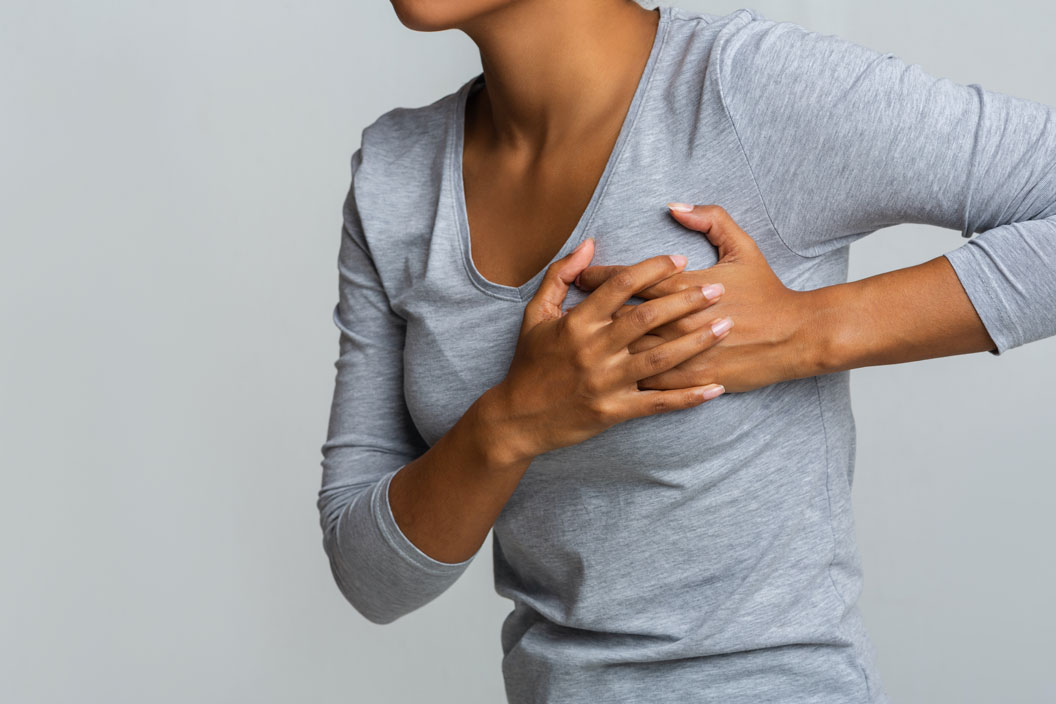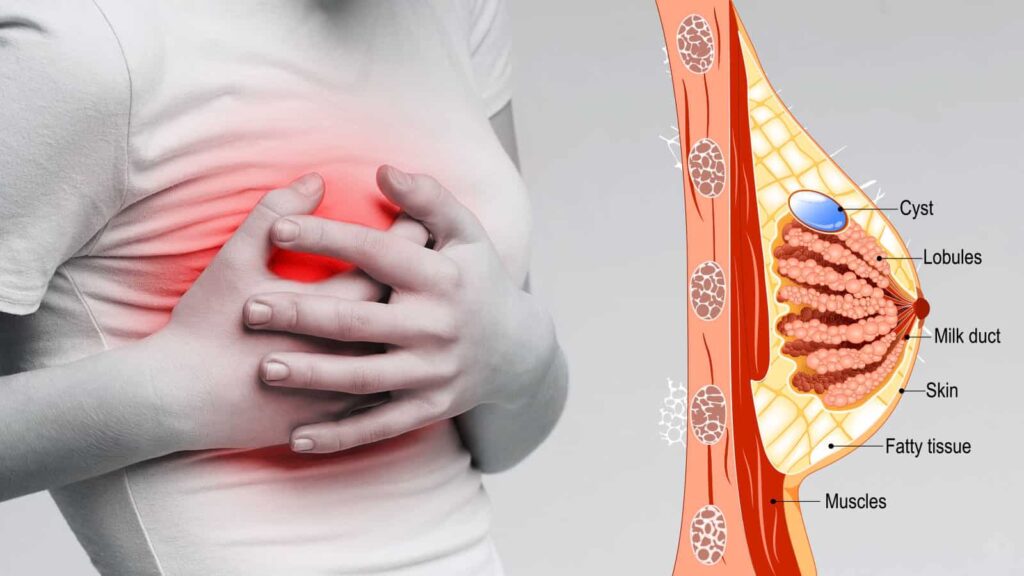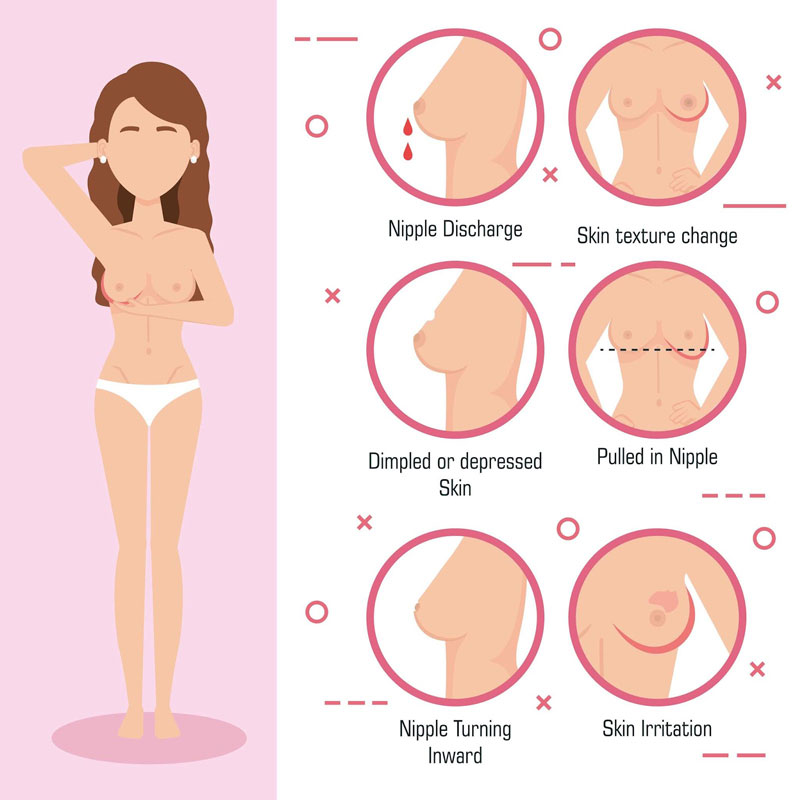WHAT IS BREAST PAIN?
Breast pain or mastalgia is a common problem women face. Breast pain is usually defined as cyclic or non-cyclic. Breast pain is sometimes linked to the menstrual cycle. The pain tends to subside after or during the period.
However, non-cyclic pain is associated with other causes such as injury. Non Cyclical pain sometimes could initiate from surrounding muscles or tissues instead of breast itself also referred to as extra mammary pain. Cyclic pain is more common than non cyclical pain and it is difficult to identify its cause.
Most women experience some sort of breast pain at least once in their lifetime. Breast pain is usually easy to diagnose and treat. These might range from breast soreness during menstruation to breast cysts or infections. Sometimes or chest wall pain.
Breast pain can occur in men also known as gynecomastia. This condition refers to an increase in the amount of breast gland tissue. The increase is caused by an imbalance of the hormones estrogen and testosterone.
Breast pain can affect transgender men and women also due to hormone therapy. The pain results from the minimal amount of breast tissue that may remain after a mastectomy.

WHAT ARE THE CAUSES OF BREAST PAIN?
Changing hormone levels is a result from changes in the milk ducts or milk glands. Changes in the ducts cause cysts that are painful. Noncyclic breast pain results from trauma, prior breast surgery or other factors.
Some of the common reasons for breast pain are:
Hormones: Rise in hormone level is the most common reason for breast pain or soreness. It occurs before the beginning of the menstrual cycle and leads to inflamed or tender breasts 3 to 5 days before the start of the period. You might also experience a rise in hormones during the first trimester of her pregnancy. This symptom is treatable and non-worrying.
Breast injury: Breasts consist of fat and tissues, making it prone to injury. The injury might occur during physical activity without the right support, breast surgery, or wearing tight clothing. Breast injury might cause bruising as well as sharp or shooting pain lingering for a couple of days.
Unsupportive bra: Mostly 8 out of 10 women buy the wrong size of bra causing improper support and achy or sore breast. A non-supportive or tight bra will injure the ligaments connecting the breast to the chest wall and restrict the blood circulation. This results in breast or back pain. In severe cases it might even cause breast cancer. Some of the tips that might help you pick the right and fitted bra include:
- The bra strap should not be digging into your skin. Check if you can comfortably fit two fingers between the ribcage and the bra band and
- two fingers between your strap and the shoulder.
- The underwire of the bra should lie against the sternum (breast bone in the center of the chest).
- The underwire or the elastic should cup the breast under the ribcage snuggly.
- There should be no gapping in the cup nor cup spillage. The breast should sit perfectly in the cup of your bra.
Breastfeeding: New moms having breast pain is ordinary and is a common experience during nursing. A mom will experience breast pain in conditions such as:
- Improper latch of the baby on the breast causing swollen and painful nipples.
- A tingling feeling during letdown when the milk starts flowing from the breast to the baby.
- Biting of the nipple, cracked skin or an infected nipple
Breast infection: Also called Mastitis. A breast infection causes an inflammation of the breast tissue, breast pain, redness, and flu-like symptoms. Breastfeeding women are at a higher risk of breast infection.
Medication side effect: Some medications can cause breast pain as a side effect such as hormone medication, heart medications and psychiatric drugs.
Breast cyst: Self-examination is a monthly task that every woman should implement in her routine to determine a cyst. The lump on women’s chest is usually tender fluid filled andt does not often stipulate pain but rather discomfort. Cysts could be noncancerous and not dangerous which doesn’t need treatment as well as dissolve on its own. However, it is important to see a doctor to check for cancer related symptoms.
Breast implant complication: After a breast augmentation operation, you may experience pain and tightness around the scars. This is usually due to the rupture of the implant and should be checked as soon as the pain is felt. You should see a doctor if:
- Deflation of the implant occurs over time usually due to leaking.
- Change in shape of breast
- Numbness, tingling, burning, swelling or hardening of the breast
- Lumps around the implant or in the armpit
Sign of breast cancer: Pain in the breast is not usually a sign of breast cancer. Cancer symptoms include red and swollen breasts as well as thicker or dimpled skin. The symptoms might appear suddenly and progress rapidly. These should not be ignored and checked immediately.

WHAT ARE THE SYMPTOMS OF BREAST PAIN?
The breast pain symptoms differ in case of cyclic and non-cyclic pain such as:
Cyclic Breast Pain
- Related to the menstrual cycle and changing hormone levels
- Described as dull, heavy or aching
- Frequently accompanied by breast swelling, fullness or lumpiness
- Usually affects both breasts, mainly the upper, outer portions, and might radiate to the underarm
- Intensifies during the two weeks leading up to the start of the menstrual period, then eases up afterward
- More likely to affect people in their 20s and 30s, sometimes affect people in their 40s transitioning to menopause
Non-Cyclic Breast Pain
- Unrelated to the menstrual cycle
- Described as tight, burning, stabbing or aching sensation
- Constant or intermittent
- Usually affects one breast, in a localized area, but may spread more diffusely across the breast
- Most likely to occur after menopause
It is important to see a doctor if:
- You find a lump in the area of pain
- The lump or pain does not dissolve after the recent menstrual period.
- The breast pain is getting worse and limiting you in your daily activities
- A sign of infection: redness, swelling, warmth, drainage in the affected area
- Bruised breast
- Nipple discharge
- The breast pain is concentrated in one area and not around the whole breast.
- Severe Swelling

WHAT ARE THE TREATMENTS OF BREAST PAIN?
Not all breast pain is related to cancer. Thus you should not panic and rush to a doctor. You should check the location of breast pain and if it is severe or critical. Some of the home remedies that help you are:
- Detecting the factor of the pain and eliminating it. Adjusting your bra or changing bras all together helps in most cases.
- Taking non inflammatory medication or over the counter pain relievers such as Tylenol or ibuprofen
- Using a hot or cold compress towel on the affected area
- Switching birth control is causing the pain then consult a doctor to switch or remove the pill altogether
- Reducing your sodium intake
- Taking calcium supplements
- Taking estrogen blockers, such as tamoxifen
- Weight loss especially if you have fat around the breast
Treatment of the non-cyclic pain depends on its cause. It is important to see a doctor if you feel a lump in the breast with pain.
OUTLOOK
Breast Pain is common with women worldwide and is nothing to panic about. Leading a healthy lifestyle and conducting monthly checkups are the prime steps that one can take to reduce the risk of breast pain.
If you or anyone you know is suffering from breast pain, our expert providers at Specialty Care Clinics will take care of your health and help you recover.
Call us on (469) 545-9983 to book an telehealth appointment with our specialists.
